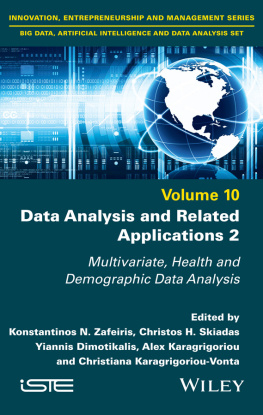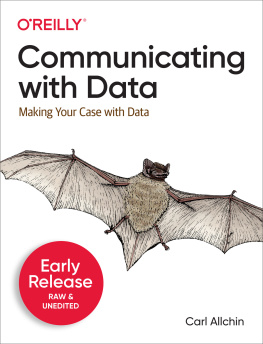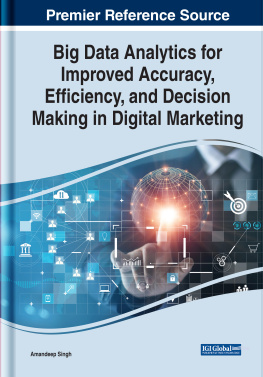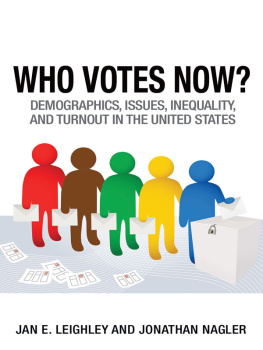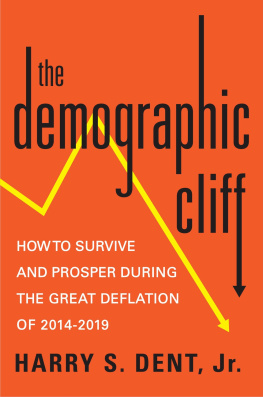First published 2006 by Paradigm Publishers
Published 2016 by Routledge
2 Park Square, Milton Park, Abingdon, Oxon OX14 4RN
711 Third Avenue, New York, NY 10017, USA
Routledge is an imprint of the Taylor & Francis Group, an informa business
Copyright 2006, Taylor & Francis.
All rights reserved. No part of this book may be reprinted or reproduced or utilised in any form or by any electronic, mechanical, or other means, now known or hereafter invented, including photocopying and recording, or in any information storage or retrieval system, without permission in writing from the publishers.
Notice:
Product or corporate names may be trademarks or registered trademarks, and are used only for identification and explanation without in tentto infringe.
Library of Congress Cataloging-in-Publication Data has been applied for.
ISBN 13: 978-1-59451-177-6 (hbk)
ISBN 13: 978-1-59451-178-3 (pbk)
Demographics is a term that is increasingly familiar to the public and part of the essential lexicon for members of the media, human resource specialists, and public-and private-sector managers at all levels. Nearly everyone is familiar with the general term: that of the size and characteristics of a population that affect a populations use of, its participation in, and/or its access to specific types of goods and services. Thus, one commonly hears that a particular television show is intended to reach a specific demographic, that various markets for goods and services are intended for specific demographic niches, that the workforce will age and become increasingly diverse.
Despite such familiarity, it is often difficult for those who are not professional demographers to locate and effectively use demographics. How does one find data on workforce characteristics, on the number of persons with specific income levels, and on the related consumer expenditures, service usage, or tax revenues related to specific population segments? When one locates such data, they are often conveyed in technical terminology and in terms of mathematical and statistical rates that are alien to lay users.
This work attempts to address such issues for the nondemographer professional. Its purpose is to provide a single-source reference book that explains basic demographic concepts and widely used methods and that describes the basic sources for specific types of demographic, economic, and other socioeconomic and service information. It provides examples of data use and misuse and provides specific guidance for the use of demographics in news stories, in the administration of personnel programs, in the analysis of market areas and segments, in facility and fiscal planning and location analyses, and in numerous other areas.
This work is intended to serve a wide range of professionals, such as reporters with a demographic beat, human resource professionals responsible for EEOC compliance or pension fund projections, marketing analysts completing site locations, segmentation, and other analyses for clients, business managers of both for-profit and nonprofit organizations who wish to make fact-based decisions, and students in college and continuing education courses. The volume is also intended as a supplementary text for courses in media analysis, marketing analysis, and methods of business management, as well as for basic applied and undergraduate demography and social science research methods courses.
Reflecting the attempt to reach a wide audience of users, the authors are also a diverse group. We include university professors and researchers who teach courses in this area, data specialists who work directly with data users from across the nation, and a media analyst who has used demographic data for more than 25 years. What binds us together is that we are all engaged in the use of demographic data and methods with a variety of private- and public-sector users and by the fact that we are involved in extensive demographic research and other activities with businesses in the areas of personnel management, labor force analyses, organizational management, and business marketing and location analyses.
As with any work on data sources and uses, this volume will inevitably be an incomplete source on data and methods for some users. It is simply impossible, given the bourgeoning number of sources and uses, for any one volume to be anything but incomplete. We hope we have been relatively inclusive, however, and for those who do not find what they are looking for in this volume, we advise them to keep searching for their best source of information and the most appropriate ways dto use such information because there is a wider range of readily available sources than ever before. We hope for the users of this volume that we have at least provided a place to start, a beginning point for locating and using data.
We wish to thank those who have assisted us in the preparation of this work. We thank the Institute for Demographic and Socioeconomic Research and The University of Texas at San Antonio that provided support for the work. We also wish to thank numerous individuals, including Dr. Don Warren who assisted in proofing and reviewing several sections of the work, David Wang who recalculated rates for use in , David Donovan who helped us refine our index, and Sheila Dos Santos-Dierking who read the entire text and made useful comments that improved several sections. We especially thank Andrea Chrietzberg who carefully typed and retyped different versions of the manuscript and Charla Wright-Adkins who helped us finalize the text. We owe special appreciation to Patricia Bramwell who ensured that all parts of the preparation process were completed in a timely manner and who always managed to keep us working harmoniously even during periods of substantial stress. Finally, we express our utmost appreciation to Karen White who carefully edited the entire manuscript, seamlessly merged the work of diverse authors into an integrated document, and ensured not only consistency and accuracy in the work but also its readability.
In preparing this work, the authors have also benefited from the work of many others whom we cite throughout the text. Others to whom we owe a special debt of gratitude cannot be cited because they are so numerous, and many are unknown to us by name: those who, in requesting demographic data from us and using it for their purposes, have helped to inform and educate us in the methods and forms of data use. We thank all of them and hope at least some of them will be rewarded by finding in this volume a source that will help them in locating and effectively using data in their current and future endeavors.
Chapter 1
Introduction: Demographics in the Media, Business, and Government
This is a volume dedicated to helping readers learn how to locate and effectively use demographic and related data. It is intended for use by members of the media, human resource specialists, marketing specialists, public- and private-sector managers at all levels, and beginning students in demography and social science courses who use demographic data and techniques to address specific issues and needs. But what is demography and demographics and how are they used in the professional and applied worlds? In this introductory chapter, we begin by defining what we mean by demography and demographics and by delineating what is and what is not included when we use such terms. We then provide a brief overview of what the text will examine, and we conclude with a description of the specific organization of the remainder of the text and the limitations of the work.


